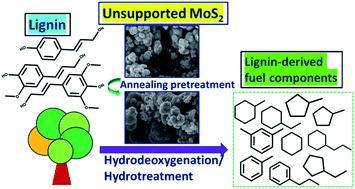当前位置:
X-MOL 学术
›
Sustain. Energy Fuels
›
论文详情
Our official English website, www.x-mol.net, welcomes your feedback! (Note: you will need to create a separate account there.)
Thermal annealing effects on hydrothermally synthesized unsupported MoS2 for enhanced deoxygenation of propylguaiacol and kraft lignin
Sustainable Energy & Fuels ( IF 5.6 ) Pub Date : 2021-09-14 , DOI: 10.1039/d1se00686j You Wayne Cheah 1 , Muhammad Abdus Salam 1 , Joby Sebastian 1 , Sreetama Ghosh 1 , Olov Öhrman 2 , Derek Creaser 1 , Louise Olsson 1
Sustainable Energy & Fuels ( IF 5.6 ) Pub Date : 2021-09-14 , DOI: 10.1039/d1se00686j You Wayne Cheah 1 , Muhammad Abdus Salam 1 , Joby Sebastian 1 , Sreetama Ghosh 1 , Olov Öhrman 2 , Derek Creaser 1 , Louise Olsson 1
Affiliation

|
Catalytic hydrodeoxygenation (HDO) is an important hydrotreating process that is used to improve the quality of bio-oils to produce biomass-derived fuel components and chemicals. Molybdenum disulfide (MoS2) has been widely used as a catalyst in hydrodesulfurization (HDS) applications for several decades, which can be further improved for effective unsupported catalyst synthesis. Herein, we studied a universally applicable post-annealing treatment to a hydrothermally synthesized MoS2 catalyst towards developing efficient unsupported catalysts for deoxygenation. The effect of the annealing treatment on the catalyst was studied and evaluated for HDO of 4-propylguaiacol (PG) at 300 °C with 50 bar H2 pressure. The annealing of the as-synthesized catalyst under nitrogen flow at 400 °C for 2 h was found to enhance the HDO activity. This enhancement is largely induced by the changes in the microstructure of MoS2 after the annealing in terms of slab length, stacking degree, defect-rich sites and the MoS2 edge-to-corner site ratio. Besides, the effect of hydrothermal synthesis time and acid addition combined with the annealing treatment on the MoS2 catalytic activity was also studied for the same model reaction. The annealed MoS2 with a synthesis time of 12 h under an acidic environment was found to have improved crystallinity and exhibit the highest deoxygenation degree among all the studied catalysts. An acidic environment during the synthesis was found to be crucial in facilitating the growth of MoS2 micelles, resulting in smaller particles that affected the HDO activity. The annealed unsupported MoS2 with the best performance for PG hydrodeoxygenation was further evaluated for the hydrotreatment of kraft lignin and demonstrated a high deoxygenation ability. The results also indicate a catalyst with high activity for deoxygenation and hydrogenation reactions can suppress char formation and favor a high lignin bio-oil yield. This research uncovers the importance of a facile pretreatment on unsupported MoS2 for achieving highly active HDO catalysts.
中文翻译:

热退火对水热合成无载体二硫化钼的影响,以增强丙基愈创木酚和硫酸盐木质素的脱氧
催化加氢脱氧 (HDO) 是一种重要的加氢处理工艺,用于提高生物油的质量,以生产生物质衍生的燃料成分和化学品。几十年来,二硫化钼 (MoS 2 ) 已广泛用作加氢脱硫 (HDS) 应用中的催化剂,可以进一步改进以实现有效的无载体催化剂合成。在此,我们研究了一种普遍适用的水热合成 MoS 2催化剂的后退火处理,以开发用于脱氧的高效无载体催化剂。研究了退火处理对催化剂的影响,并在 300 °C 和 50 bar H 2 条件下评估了 4-丙基愈创木酚 (PG) 的 HDO压力。发现合成的催化剂在氮气流下在 400°C 下退火 2 小时可提高 HDO 活性。这种增强主要是由退火后MoS 2微观结构在板坯长度、堆积程度、缺陷丰富位点和 MoS 2边角位点比方面的变化引起的。此外,还针对相同的模型反应研究了水热合成时间和酸添加结合退火处理对MoS 2催化活性的影响。退火的 MoS 2发现在酸性环境下合成时间为 12 小时的催化剂具有改善的结晶度,并且在所有研究的催化剂中表现出最高的脱氧度。发现合成过程中的酸性环境对于促进 MoS 2胶束的生长至关重要,从而产生影响 HDO 活性的较小颗粒。具有最佳PG加氢脱氧性能的退火无载体MoS 2被进一步评估用于硫酸盐木质素的加氢处理,并显示出高脱氧能力。结果还表明,对脱氧和加氢反应具有高活性的催化剂可以抑制炭形成并有利于高木质素生物油产率。这项研究揭示了对不受支持的 MoS 进行简单预处理的重要性2用于实现高活性 HDO 催化剂。
更新日期:2021-09-23
中文翻译:

热退火对水热合成无载体二硫化钼的影响,以增强丙基愈创木酚和硫酸盐木质素的脱氧
催化加氢脱氧 (HDO) 是一种重要的加氢处理工艺,用于提高生物油的质量,以生产生物质衍生的燃料成分和化学品。几十年来,二硫化钼 (MoS 2 ) 已广泛用作加氢脱硫 (HDS) 应用中的催化剂,可以进一步改进以实现有效的无载体催化剂合成。在此,我们研究了一种普遍适用的水热合成 MoS 2催化剂的后退火处理,以开发用于脱氧的高效无载体催化剂。研究了退火处理对催化剂的影响,并在 300 °C 和 50 bar H 2 条件下评估了 4-丙基愈创木酚 (PG) 的 HDO压力。发现合成的催化剂在氮气流下在 400°C 下退火 2 小时可提高 HDO 活性。这种增强主要是由退火后MoS 2微观结构在板坯长度、堆积程度、缺陷丰富位点和 MoS 2边角位点比方面的变化引起的。此外,还针对相同的模型反应研究了水热合成时间和酸添加结合退火处理对MoS 2催化活性的影响。退火的 MoS 2发现在酸性环境下合成时间为 12 小时的催化剂具有改善的结晶度,并且在所有研究的催化剂中表现出最高的脱氧度。发现合成过程中的酸性环境对于促进 MoS 2胶束的生长至关重要,从而产生影响 HDO 活性的较小颗粒。具有最佳PG加氢脱氧性能的退火无载体MoS 2被进一步评估用于硫酸盐木质素的加氢处理,并显示出高脱氧能力。结果还表明,对脱氧和加氢反应具有高活性的催化剂可以抑制炭形成并有利于高木质素生物油产率。这项研究揭示了对不受支持的 MoS 进行简单预处理的重要性2用于实现高活性 HDO 催化剂。



























 京公网安备 11010802027423号
京公网安备 11010802027423号